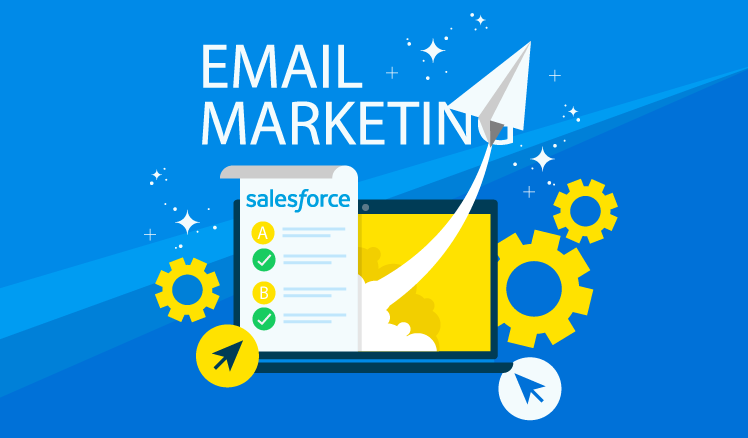How Salesforce finds solutions to key email marketing challenges
Editor's note: The topic of our article is narrowed to email marketing. However, our knowledge and expertise is much wider - we provide all-round marketing automation services and work with different marketing channels.
The capabilities of modern email marketing tools are not limited to email automation – rather they allow solving intricate marketing tasks, like customer segmentation, for more effective campaigns. In order not to sound ungrounded, we combine here our knowledge of key email marketing challenges and our expertise in Salesforce Marketing Cloud (formerly known as ExactTarget) as a robust marketing tool. Let’s see whether it can be truly effective on the way to a larger target audience, higher investment returns, and advanced email analytics.

Task 1. Growing a subscriber base
The outcomes of efforts and time invested in email marketing largely depend on how effectively marketers grow a subscriber base. Given that average open and click-through rates are not generally high (e.g., 15.66% and 2.07% respectively for ecommerce emails according to the MailChimp report), ROI for working with a small audience goes into the red.
Marketers engage various ways to grow their email list. To name a few, they ask customers to register an account to purchase, encourage them to subscribe for a newsletter or collect contact details during on-site promotional events. These techniques have proved to be effective. Salesforce Marketing Cloud offers some non-trivial ideas for those seeking to access a larger potential audience.
How Salesforce Marketing Cloud comes to help
Marketers can attract new subscribers by building Facebook Lookalike Audiences in Advertising Studio. They leverage the CRM data about their current customers to find people with similar personal characteristics (age, gender, marital status), interests, occupation, etc. This technique works its best when marketers take their high-valued customer segments as a basis for a lookalike audience. When aiming to grow a subscriber base, they can start with creating a segment of customers who regularly open the emails. To configure settings for a search, they choose to optimize it for reach (for larger coverage) or similarity (for a more precise match). When the audience has been created, marketers further use the functionality of Advertising Studio to come up with targeted Facebook ads for them. As a result, they reach a brand new audience of potential newsletter subscribers.
Salesforce Data Studio is another way to discover new audiences. This data sharing platform eliminates the role of intermediaries in the process of purchasing audience data and creates a transparent and safe environment for companies to contact data owners directly. The advantage of purchasing second-party data is its higher quality and accuracy comparing to third-party data. Marketers can tap into email lists that comply with their business. Let’s say a furniture brand can use Data Studio to find self-employed designers and offer them a subscription to weekly newsletters.
Task 2. Automating customer segmentation and email personalization
Choosing bulk emailing as a time-effective way to do email marketing, companies risk to have their emails unopened and collecting dust in customers’ email boxes. The key to email marketing success is understanding what message is helpful to a particular customer (depending on their personal characteristics, interests, a current stage of the customer lifecycle) and tailoring communication accordingly. Customer segmentation and email personalization are ultimate techniques for this.
How Salesforce Marketing Cloud comes to help
To get a consolidated view of its audience and trigger customer segmentation, a company needs to centralize customer data. In Email Studio, Data Extensions fulfill the role of a customer database. Set out in the form of tables with attributes, Data Extensions can be customized to store particular types of customer data (contact data, purchasing history, interactions with a company, rewards program data, etc.). From there, marketers can apply filters to Data Extensions to build customer segments for email marketing campaigns.
The next step marketers take towards effective email communication is analyzing what value they can bring to customers from different segments with their messages. Let’s say they are planning an email campaign based on a customer lifecycle. They segment customers into first-time, repeat and at-risk repeat, and tailor the campaign to each segment:
- First-time customers are new to the brand. Marketers can greet them with a series of welcome emails where they can tell the brand’s history and show the team standing behind it. This allows a customer to feel a part of the community.
- Repeat customers have returned to the company after the first purchase. It is high time to strengthen further their loyalty and use their shopping experience to assess the quality of services. Marketers can schedule a weekly email with new product offerings and add an experience survey for repeat customers. An email with an exclusive discount coupon will be a significant contribution to their loyalty.
- At-risk repeat customers haven’t purchased for quite a time, so the aim for marketers is to win them back. Emails with time-sensitive coupons may work out well for this customer segment. Experience surveys will be useful as well to understand why customers went away.
Now that marketers have outlined the idea of an email campaign, they go to Salesforce Content Builder to bring it to life. Even though they are going to create several email types (a welcome email, experience surveys, etc.) to tailor the communication to customer segments, they will naturally seek to add a personal touch for each customer. Fortunately, Salesforce Marketing Cloud provides for email personalization functionality. Check our Guided Tour to find how to create personalized marketing journeys in Salesforce.
Along with static content in emails (like a company logo), marketers can create individualized content. There is an option to add any field with information from the related Data Extension to an email. In such a way marketers can personalize, say, a recipient’s name. Still, the process of creating advanced personalization is more complicated. There are two ways to add individualized content.
- As a first option, marketers can select a dynamic content block and define a rule on how the content will be rendered for each particular customer. A possible use case for such rule-based personalization is an email with new female or male arrivals (a gender-based rule).
- When a more sophisticated personalization is needed, marketers can seek Salesforce consulting services because from now on the discussion will turn to AMPscript. The script is embedded into an HTML code of an email and gets processed together with the start of email sending. It interacts with the Data Extension and renders the content. For example, when used for emails with personalized product offerings, the script changes products subscriber-by-subscriber depending on their history stated in the Data Extension.
Task 3. Increasing visibility into email marketing performance
Even with all the efforts made to grow a subscriber base and reach right customers with right messages, marketers cannot succeed without thinking forward. Only tracking email marketing KPIs and drawing actionable conclusions about the effectiveness of their campaigns, they can consistently adjust the marketing strategy. They should give full play to the historical data from previous campaigns to better understand customers – which ideas have worked out and led to increased sales and which ones haven’t paid off and are not worth investing efforts into.
How Salesforce Marketing Cloud comes to help
Marketers stay blind about the effectiveness of their efforts if they don’t track the KPIs for their email campaigns. Salesforce Marketing Cloud turns into an advanced analytics tool to provide them with a complete picture of campaign performance. It allows companies to make informed decisions on how to develop their email marketing with maximum benefits. We have defined several functions that Salesforce Marketing Cloud performs to provide marketers with analytics capabilities.
-
Tracking email marketing performance
Email Studio in Salesforce has the tracking bar that opens user-friendly analytics dashboards for all the emails sent. Not only marketers see crucial email marketing KPIs there (deliverability, open and click-through rates), but they can also view the list of recipients who didn’t open an email. Marketers can target them specifically with a repeat one, while not annoying all the subscribers again. For emails containing several links, Salesforce provides click activity showing what links exactly customers clicked.
-
Drawing AI-powered insights
Once they have the results of email campaigns at hand, marketers have all the cards to analyze customer behavior and see whether their current approach yields expected results. Naturally, marketers rely on their experience and strategic vision but as they say – two heads are better than one. A smart Salesforce assistant – Einstein – allows multiplying their effectiveness by applying artificial intelligence to email marketing. Einstein Engagement Scoring uses historical data to assess how each customer reacts to emails: whether they open, click and stay subscribed. Based on the assigned scores, it extracts four personas in the subscriber list – Loyalists, Window Shoppers, Selective Shoppers, and Win-back/Dormant. Having these four subscriber segments automatically generated for them, marketers can differentiate communication goals and tailor the messaging to each segment. Here is an example of a possible approach.
Loyalists have high open and click rates. As they are already highly engaged, marketers may maintain their loyalty by regularly informing them about new arrivals. What is more, if they create a landing page with a new collection and give loyalists early access to it, they organize a unique offer and make customers feel special.
Window Shoppers have high open and low click rates. Here, the goal is to create more engaging content for subscribers as they obviously don’t find it appealing enough to click a link. We would suggest marketers leave out the guesswork and test various ways to encourage window shoppers to click (trying out different content types, email layout, CTAs) and track the results.
Selective Shoppers have low open and high click rates. These subscribers rarely open emails but if they do, they are likely to click. The focus here is on catchy subject lines. Marketers can achieve a higher open rate by experimenting with their length and tone.
Win-back/Dormant have low open and click rates. Marketers need to come up with a message truly valuable for such subscribers and translate this value in the subject line. Offering a time-sensitive discount can be a catch.
-
Engaging A/B testing
For marketers who target to increase the effectiveness of their email campaigns, Salesforce Content Builder offers just the right tool – A/B Testing. While designing emails, marketers choose the content block called A/B Test, add the variables and set what percentage of the target audience receives each version. After the campaign, they get visualized results and can apply them further on. Thus, marketers can test different email elements to understand which ones give tangible results.
We have researched – now we can draw a conclusion
With our article, we intended to show how Salesforce Marketing Cloud can cope with critical email marketing challenges – winning an audience, raising the effectiveness of emails and tracking the results of campaigns. It has proved to be technically robust to become the marketers’ right hand on their way to successful email marketing – automated, personalized, and AI-powered. Now that our readers know the theory, we offer them to try out a Salesforce Marketing Cloud demo to get a hands-on experience of developing email marketing campaigns in Salesforce.

